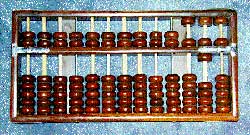算盤是怎么來的(通訊員稿)
[ 2006-11-27 15:32 ]
算盤是人類歷史上一種重要的計算工具,被稱為"現(xiàn)代計算機(jī)"的前身。現(xiàn)在,就讓我們來探究一下算盤的歷史吧!
 The origins of the abacus are disputed, as many
different cultures have been known to have used similar tools. It is known to
have existed in Babylonia and in China, and was likely invented sometime between
1000 BCE and 500 BCE. The first abacus was almost certainly based on a flat
stone covered with sand or dust. Lines were drawn in the sand and pebbles used
to aid calculations. From this, a variety of abaci were developed; the most
popular were based on the bi-quinary system, using a combination of two bases
(base-2 and base-5) to represent decimal numbers. The origins of the abacus are disputed, as many
different cultures have been known to have used similar tools. It is known to
have existed in Babylonia and in China, and was likely invented sometime between
1000 BCE and 500 BCE. The first abacus was almost certainly based on a flat
stone covered with sand or dust. Lines were drawn in the sand and pebbles used
to aid calculations. From this, a variety of abaci were developed; the most
popular were based on the bi-quinary system, using a combination of two bases
(base-2 and base-5) to represent decimal numbers.
The use of the word abacus dates back to before 1387 when a Middle English
word borrowed the word from Latin to describe a sandboard abacus. The Latin word
came from abakos, the Greek genitive form of abax ("calculating-table"). Because
abax also had the sense of "table sprinkled with sand or dust, used for drawing
geometric figures," some linguists speculate that the Greek word may be derived
from a Semitic root, ābāq, the Hebrew word for "dust." Though details of the
transmission are obscure, it may also be derived from the Phoenician word abak,
meaning "sand". The plural of abacus is abaci.
A tablet found on the island of Salamis (near Greece) in 1846 dates back to the
Babylonians of 300 BCE making it the oldest counting board discovered so far. It
was originally thought to be a gaming board. Its construction is a slab of white
marble measuring 149 cm in length, 75 cm in width and 4.5 cm thick, on which are
5 groups of markings. In the center of the tablet are a set of 5 parallel lines
equally divided by a vertical line, capped with a semi-circle at the
intersection of the bottom-most horizontal line and the single vertical line.
Below these lines is a wide space with a horizontal crack dividing it. Below
this crack is another group of eleven parallel lines, again divided into two
sections by a line perpendicular to them but with the semi-circle at the top of
the intersection; the third, sixth and ninth of these lines are marked with a
cross where they intersect with the vertical line.
Salamis: 沙拉米斯
(南開大學(xué)通訊員田墨供稿 英語點(diǎn)津Annabel 編輯)
|